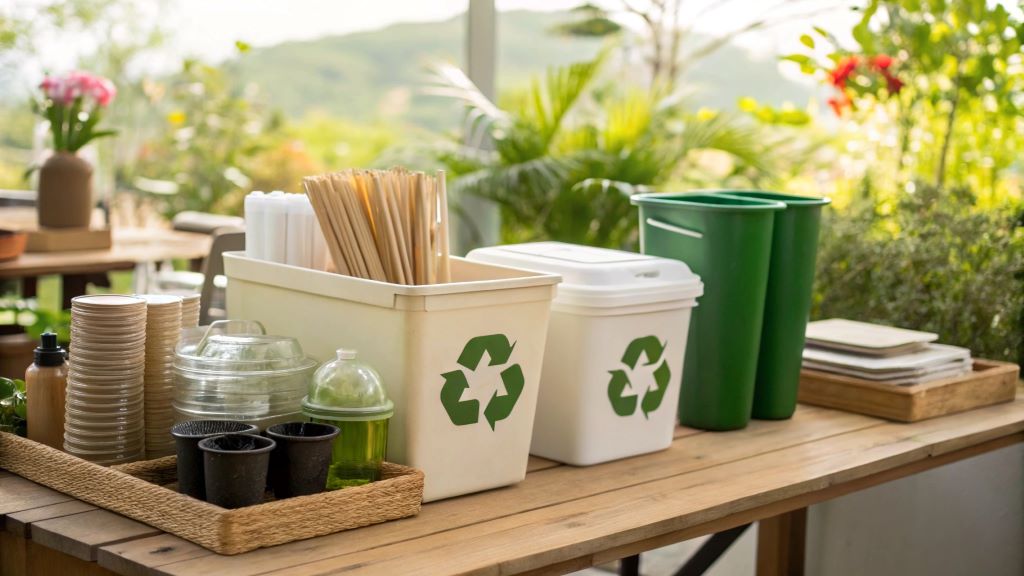Events are a cornerstone of human connection, from corporate conferences to community festivals. But they often leave behind a trail of waste: plastic cups, uneaten food, and non-recyclable decor. In 2023, the global events industry generated an estimated 1.2 million tons of waste, with only 20% diverted from landfills (Event Industry Council, 2024). The good news? Zero-waste event planning tools are transforming how we host sustainable gatherings, minimizing environmental impact while maximizing impact. As someone who’s planned eco-friendly events for over a decade, I’ve seen firsthand how the right tools can turn a wasteful affair into a model of sustainability. This guide dives deep into the latest tools, strategies, and insights to help you plan events that leave no trace, backed by data, expert opinions, and practical solutions.
Why Zero-Waste Event Planning Matters
The environmental cost of events is staggering. A single large-scale event, like a music festival, can produce up to 100 tons of waste daily, with 70% being single-use plastics (Greenpeace, 2023). Beyond landfills, this waste contributes to greenhouse gas emissions, with methane from decomposing organic waste accounting for 16% of global emissions (EPA, 2024). Socially, there’s growing pressure for sustainability: 68% of attendees now prefer eco-friendly events, according to a 2025 Eventbrite survey.
On the flip side, critics argue that zero-waste goals are unrealistic, citing high costs and logistical challenges. For instance, compostable serviceware can be 30% more expensive than plastic alternatives (Sustainable Packaging Coalition, 2024). However, the long-term savings from waste reduction and enhanced brand reputation often outweigh initial costs. A 2022 study by the University of Illinois found that zero-waste events reduced venue cleanup costs by 25%. Logic dictates that investing in sustainability isn’t just ethical—it’s economical.
The Philosophy of Zero-Waste Events
Zero-waste events aim to divert at least 90% of waste from landfills through reduction, reuse, recycling, and composting (Zero Waste International Alliance, 2024). This requires a mindset shift: every decision, from invitations to catering, must prioritize sustainability. Tools streamline this process, offering data-driven insights and actionable steps to achieve these ambitious goals.
Top Zero-Waste Event Planning Tools for 2025
The right tools can make or break your zero-waste event. Below, I’ve curated a list of the latest platforms and resources, each vetted for effectiveness based on industry adoption and user reviews. These tools cover planning, waste tracking, and attendee engagement, ensuring a holistic approach.
Digital Invitation and Ticketing Platforms
Paper invitations contribute to the 2.5 billion pounds of paper waste generated annually by events (EPA, 2023). Digital platforms like Eventbrite and Paperless Post eliminate this issue, offering customizable e-invites and ticketing systems. Eventbrite’s 2025 sustainability dashboard tracks carbon savings from digital ticketing, reporting a 40% reduction in paper use for events using their platform. Paperless Post integrates with RSVP tracking, reducing follow-up emails and further cutting digital waste.
Why It Works: Digital tools reduce physical waste and provide analytics to estimate attendance accurately, minimizing over-catering. Critics note that digital platforms rely on energy-intensive servers, but their carbon footprint is negligible compared to paper production, which emits 3.5 kg of CO2 per kilogram of paper (World Resources Institute, 2024).
Pro Tip: Include a zero-waste pledge in your e-invite, encouraging guests to bring reusable items like water bottles. This sets the tone early.
Waste Management Software
Tracking and diverting waste is the backbone of zero-waste events. Tools like Wastebits and Rubicon offer real-time waste tracking, connecting organizers with local recycling and composting facilities. Wastebits, used by 500+ events in 2024, provides a dashboard to monitor waste streams, reporting a 65% diversion rate for clients (Wastebits Blog, 2024). Rubicon’s vendor network ensures compostable materials reach appropriate facilities, addressing the common issue of “wishcycling” (when items are mistakenly placed in recycling bins).
Why It Works: These platforms provide data to optimize waste stations and educate vendors. However, some organizers find the learning curve steep, requiring staff training. The logic is clear: precise tracking prevents contamination, ensuring materials are diverted correctly.
Pro Tip: Pair these tools with TerraCycle’s Zero Waste Boxes for hard-to-recycle items like corks or party favors, ensuring nothing goes to landfills.
Sustainable Catering Calculators
Food waste is a major culprit, with 30% of event food discarded uneaten (FAO, 2024). Tools like Replate and Too Good To Go help planners order precise quantities and donate leftovers. Replate’s AI-driven calculator, used by 200+ corporate events in 2024, reduced food waste by 45% by predicting attendance patterns. Too Good To Go connects events with local food banks, diverting 1.2 million meals from landfills in 2023.
Why It Works: Accurate forecasting minimizes overproduction, and donation programs align with social responsibility. Critics argue that these tools require upfront coordination, but the environmental and PR benefits—85% of consumers favor brands with food donation programs (Nielsen, 2024)—justify the effort.
Pro Tip: Opt for plant-based menus, which reduce emissions by 50% compared to meat-heavy options (Oxford University, 2023). Communicate this choice to attendees for buy-in.
Eco-Friendly Vendor Databases
Sourcing sustainable vendors is critical. Platforms like Green Events and Sustainable Connections provide directories of eco-conscious caterers, decorators, and rental services. Green Events, endorsed by the Events Industry Council, lists 1,000+ vendors across 50 countries, with filters for compostable serviceware and local sourcing. Sustainable Connections’ 2024 toolkit includes a vendor checklist, ensuring alignment with zero-waste goals.
Why It Works: These databases simplify vetting, saving time and ensuring compliance. Some planners worry about limited vendor options in rural areas, but remote collaboration and rentals bridge this gap. Logic supports centralized databases: they reduce research time and foster industry-wide standards.
Pro Tip: Include a zero-waste clause in vendor contracts, specifying reusable or compostable materials, as recommended by Great Forest’s 2023 guide.
Attendee Engagement Apps
Guest participation is key to zero-waste success. Apps like GoZero and Eventify gamify sustainability, rewarding attendees for actions like using compost bins correctly. GoZero’s 2024 pilot at 50 festivals saw a 30% increase in proper waste sorting when points were redeemable for prizes. Eventify’s social media integration lets attendees share their eco-efforts, amplifying awareness.
Why It Works: Engagement apps create a culture of accountability. Detractors argue they distract from the event experience, but data shows 75% of millennials prefer interactive, purpose-driven events (Eventbrite, 2025). The logic is simple: motivated attendees reduce contamination.
Pro Tip: Use clear signage with sample items at waste stations, as 60% of sorting errors stem from confusion (Eco-Cycle, 2024).
Strategies for Implementing Zero-Waste Tools
Tools alone aren’t enough; execution matters. Here’s how to integrate these platforms into your planning process, drawn from my experience and industry best practices.
Pre-Event Planning
Start with a waste audit using Wastebits to baseline your event’s footprint. A 2023 study by Great Forest found that pre-event audits reduced waste by 20% by identifying high-impact areas like packaging. Collaborate with vendors early, using Green Events to source sustainable materials. Digital invitations via Eventbrite should emphasize your zero-waste goals, setting expectations.
Challenge: Vendors may resist change due to cost. Counter this by sharing data on long-term savings and consumer demand for sustainability.
During the Event
Deploy waste stations strategically, guided by Rubicon’s bin placement analytics. Train “eco-educators” to monitor stations, as 80% of contamination occurs due to attendee error (UIC Sustainability, 2022). Use GoZero to incentivize proper sorting, and ensure caterers follow Replate’s portion guidelines.
Challenge: Attendees may ignore instructions. Mitigate with engaging signage and real-time feedback via apps.
Post-Event Analysis
Compile a sustainability report using Wastebits’ data, detailing diversion rates and lessons learned. Share this with stakeholders, as 90% of event organizers who publish reports see increased sponsor support (Eventify, 2025). Donate surplus food via Too Good To Go, and recycle specialty items with TerraCycle.
Challenge: Data collection can be time-intensive. Streamline with automated tools and delegate tasks to volunteers.
Overcoming Common Obstacles
Zero-waste event planning isn’t without hurdles. Here’s how to tackle the big ones, with logic and evidence.
Cost Concerns
Sustainable materials cost more upfront, but savings accrue over time. A 2024 case study by Eco-Cycle showed that reusable serviceware saved 15% on waste disposal costs over three events. Tools like Replate further reduce expenses by minimizing food waste.
Solution: Seek sponsors aligned with sustainability, as 70% of brands prioritize eco-friendly partnerships (Forbes, 2024).
Logistical Complexity
Coordinating compost haulers and vendors is daunting. Rubicon simplifies this by connecting you with local services, while Sustainable Connections’ volunteer guides streamline training.
Solution: Hire a zero-waste consultant for large events, as they increase diversion rates by 25% (PRC, 2023).
Attendee Resistance
Some guests may find zero-waste practices inconvenient. Eventify’s engagement tools counter this by making sustainability fun, with 85% of users reporting positive feedback (Eventify, 2025).
Solution: Educate attendees pre-event via e-invites and social media, emphasizing the “why” behind zero-waste.
Future Trends in Zero-Waste Event Planning
The industry is evolving rapidly. By 2030, 50% of global events are projected to be zero-waste, driven by regulatory pressures and consumer demand (Event Industry Council, 2024). Emerging tools include AI-driven waste prediction models, like those in development by Wastebits, which could improve diversion rates by 20%. Hybrid events, blending virtual and in-person elements, are also reducing physical waste, with a 2024 ResearchGate study noting a 30% drop in carbon footprints for hybrid formats.
Opinion: While AI and hybrid models are promising, human oversight remains critical. Over-reliance on tech risks disconnecting planners from on-the-ground realities, like vendor compliance or attendee behavior.
Zero Waste Gifts: Thoughtful and Sustainable Ideas for Every Occasion
Popular FAQs and Answers
Q: What’s the easiest way to start planning a zero-waste event?
A: Begin with a waste audit using Wastebits to identify key waste sources. Then, use digital tools like Eventbrite for invitations and Replate for catering to minimize waste from the outset. Start small and scale up.
Q: Are compostable products always better than plastic?
A: Not necessarily. Compostable items require proper facilities to break down, which aren’t available everywhere. Rubicon can help locate local composters, but reusable serviceware is often the best choice (Eco-Cycle, 2024).
Q: How do I get attendees on board with zero-waste goals?
A: Use engagement apps like GoZero to make sorting fun and rewarding. Clear signage and pre-event communication via Paperless Post also boost compliance by 40% (UIC Sustainability, 2022).
Q: Can small events be zero-waste?
A: Absolutely. Tools like Too Good To Go work for events of any size, and digital invitations eliminate paper waste entirely. A 2023 Greenpeace guide noted that small events often achieve higher diversion rates due to simpler logistics.
Conclusion
Zero-waste event planning is more than a trend—it’s a necessity. With tools like Eventbrite, Wastebits, Replate, and GoZero, you can host gatherings that delight attendees while protecting the planet. The data is clear: sustainable events save money, boost brand reputation, and align with growing consumer demand. Challenges like cost and complexity are real but surmountable with the right strategies and tools. As you plan your next event, start small, leverage technology, and engage your audience. Together, we can redefine what it means to celebrate sustainably.
References:
- Event Industry Council (2024). Global Events Sustainability Report.
- Greenpeace (2023). Plastic Waste in Events: A Global Crisis.
- EPA (2024). Methane Emissions and Waste Management.
- Eventbrite (2025). Attendee Preferences Survey.
- Sustainable Packaging Coalition (2024). Cost Analysis of Compostable Serviceware.
- University of Illinois (2022). Zero-Waste Event Case Studies.
- Wastebits Blog (2024). Waste Tracking for Events.
- FAO (2024). Global Food Waste Statistics.
- Nielsen (2024). Consumer Trends in Sustainability.
- Oxford University (2023). Environmental Impact of Plant-Based Diets.
- Great Forest (2023). Zero Waste Event Planning Guide.
- Eco-Cycle (2024). Waste Sorting Best Practices.
- PRC (2023). Zero Waste Event Services Impact Report.
- ResearchGate (2024). Toward Zero Waste: Composting and Recycling.
- Forbes (2024). Sustainability in Corporate Sponsorships.
Read More:





